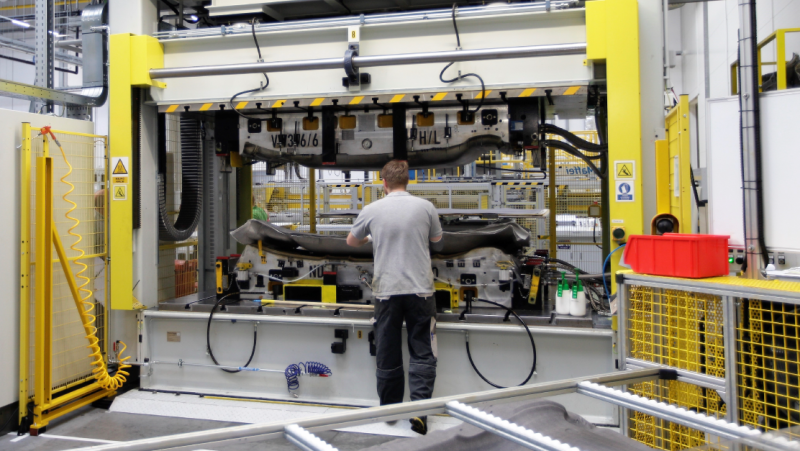Without EDI, Industry Would Not Be Where It Is Today
- Digital Factory
- Article
No matter whether you supply components to an automaker regularly or have only sent it a one-off shipment of office supplies, you’ve definitely heard of EDI. Electronic data interchange is a commonplace part of enterprise systems in a variety of areas today – and in automotive especially. And yet the story of EDI is utterly Hollywood-worthy – the Cold War, running across the city with diskettes, a boom alongside the Internet, and even disappearing people and a transition to the world of the future and unknown technologies. Electronic data interchange is sometimes thought of today as a mere necessity – a mere market requirement. But it’s important to keep in mind that it is one of the key factors for success in industry, that it enables faster and more precise manufacturing and logistics and that many of the products we use every day could not have been born without it.
EDI’s beginnings – from the first standards to wireless transmission
It may seem like EDI is intertwined with the internet. But the truth is that it was here much earlier, and even before the first computers. Its history reaches back to the Cold War, when Army Master Sergeant Ed Guilbert and the American Army’s entire logistics team faced a demanding task: supplying West Berlin during the Berlin Blockade. It was at this time that the first EDI standards and the notion of exchanging data in logistics were born. In 1948, Guilbert created standardised shipping documents – but it took another twenty years before these were transferred into an electronic form. In the 1960s, EDI’s era truly arrived – the first EDI messages were sent across the Atlantic using a telegraph, and electronic data interchange also began to expand into new fields. In 1975, its first official standards were published, and with the rise of computers, a new chapter in data interchange began to be written.
In the Czech Republic, the beginnings of EDI’s mass expansion arrived along with other Western trends: after 1989. If you speak with the old hands who were there for the introduction of data interchange, you’ll learn that stock trading was among the first Czech EDI projects. Data, along with commands, was carried from banks on physical media to the securities centre, which processed that data. Another example is Čepro. This Czech company developed its own satellite-based communication network for the flow of business documents among suppliers, its warehouses, business centres and the invoicing department. Here EDI played a key role in stocktaking as well. Although stock was taken physically, the inventory counts were imprecise due to deviations. Thanks to the transmission of data on the amounts of goods supplied and sold, a very precise overview of the state of their stocks could be kept, saving them no small amount of taxes related to missing and excess stock.
On-premise and EDI specialists
To be human is to want to possess. And companies, too, want to possess their own affairs, and they thus long used on-premise EDI tools under the administration of an internal EDI specialist. This person was, and in many companies still is, irreplaceable – infused with enormous know-how. After all: over time, every branch of industry has evolved, or rather adapted, EDI standards for its own needs. Because of this, individual messages often differ despite the fact that e.g. automotive and retail use the same standard. Messages based on the same standard can even differ within a single branch of industry at different companies. In the on-premise era, all of these differences had to be addressed by an internal employee. They had to configure systems, adjust them, implement new requirements and – when an outage, error or problem arose – be there to fix them. Immediately. Whenever and wherever. And as you might suspect, that’s unsustainable.
Smart companies thus began to make use of external specialists. Although they each still had their own system and internal team, it “only” took care of day-to-day operations, with the outside supplier handling any complicated adjustments and configuration. They also ensured that messages arrived on-time and in line with customer requirements. It was no exception for an external specialist like this to travel over 5,000 kilometres per month. But this as well is changing.
Outsourcing and the Cloud Age
Standards continue to multiply, and with every new change, your EDI supplier must be certain that you will comply with both today’s and yesterday’s regulations, because not everyone adopts standards at the same time. For internal teams, this is a practically unsolvable problem, especially since no “school of EDI” exists, and so specialists have to make do with what they learn during their careers. Outsourcing has become the logical solution.
Once companies successfully outsourced their EDI processing, they gradually began to learn that there’s actually no need to keep their system in-house. The shift to data centres arrived – and these were also easier for external consultants to connect to. This approach is preserved in many companies to this day. From here it’s just a small step to cloud systems, where we can see a parallel with other life trends – for example car ownership, which for certain parts of the populace is unnecessary. Just like having a full set of tools at home when we can just borrow what we need instead. Cloud services work similarly – you just turn on the individual services that you need and turn them off when they’ve become extraneous.
Benefits of cloud EDI:
| Comprehensiveness | The EDI supplier has to guarantee that messages comply with both today’s standards and their historical versions, that messages can be delivered and that the software is up-to-date. |
| Financial flexibility | It’s often much simpler to obtain approval for operating costs in the form of software fees than for an investment into a new system |
| Overall flexibility | When you’re using EDI as a service, you can simply turn on the services you need and turn off the ones you won’t use. |
| Easy licensing | You don’t need to buy just a certain number of licenses; you can make supplementary purchases and cancellations license-by-license, which is more economical and flexible |
Conversion settings must be watched constantly
When a customer (for example an OEM) has adjusted a standard to meet their needs, the standard becomes non-standard. This is when a team of conversion configuration specialists – “mappers” – jumps in. These EDI specialists develop mappings (conversions). But mapping is more than just defining that field A in one system is field B in another. Often it means gathering data from several systems and doing difficult programming based on special conditions directly within the conversion. Each mapper must know the logistics concepts of customers (OEMs) and the processes at the company. The team on the side of the EDI supplier must cooperate very closely with the customer’s heads of logistics and IT to configure everything needed. But how do you choose the right EDI supplier?
Your EDI supplier should act as your partner
You can find a number of EDI service providers out there on the market. You should always be watching for one who will be not just a supplier, but also a true partner – the kind that will help with your EDI communication from start to finish. Look for signs such as:
- Independence from any specific EDI products/technologies – are you using multiple systems for your EDI communication? With system-specific specialists, you’ll need one for each system. That’s not good…
- Protocols and formats – is your supplier able to connect with partners over a wide range of standard communication protocols? Are they up to speed with the very latest standards?
- Notifications about new updates – is the supplier watching developments on the market and at your EDI partners and alerting you when the need for changes arrives? Do they work with you in advance to address the release of a new standard or certification?
- System operations monitoring – do you have access to reporting on whether or not your messages are delivered?
- Conversion from anything to anything – does the supplier develop their own mapping? Are they able to adapt to demands for a new document and message formats or to special customer demands?
- Comprehensiveness – does the supplier handle EDI for you in its entirety, or is it merely a communications tool, with most of the responsibility lying on your side?
Can mapping development be left to machines?
Market players large and small are experimenting with automatic mapping development with help from machine learning. But as is becoming clear, the world of EDI is, despite its standardisation, so full of exceptions that people will not be replaced by machines here any time soon. At least how that’s how it seems based on the current situation, where teaching a computer all of the exceptions still takes more time and money than setting it all up manually. However, making at least partial use of machine learning has shown itself to be one road forward. In this case, the algorithm takes care of 80 to 90 percent of the mapping development, and an EDI specialist then checks the result and fills in the remainder – but this remainder is key for flawless EDI communication. As the number of adjustment demands grows and as EDI expands into other fields, efficiency is becoming the most important thing for mappers, and machine learning can improve it.
What awaits EDI in the future?
EDI has an unbelievable road behind it, and despite past prognoses saying it would wither and die, it has on the contrary shown itself to be irreplaceable for industrial production. We can take as proof of this its expansion into other fields and the pressure to introduce it within more and more links of the supply chain. Meanwhile, besides traditional EDI in the form of VDA/EDIFACT files and communication channels such as OFTP2, newer technologies are rushing to the forefront as well. The world of B2B integrations is making ever more frequent use of transfers over https, queries over an API, and the XML and JSON formats. EDI is thus no longer just electronic data interchange. Today it is a tool for supply chain integration. Mere exchange of documents in an electronic form has grown into a tool for increasing efficiency and productivity thanks to more precise information for the warehouse, the purchasing room and the production hall. As the supply chain becomes more and more tightly integrated and the pressure grows for it to become more and more transparent and visible, EDI is becoming a key element for keeping things flowing smoothly during the manufacturing of a growing number of goods. And with the growing volume of data, which will need to be processed with an advancing internet of things, it is more than likely that EDI will take on an important, or even leading, role in this area as well. What began as a necessity in the age of handwritten information has taken on the role of a mediator in communication among machines.
Share article
Top stories from logistics, production and IT.
Subscribe to Aimtec Insights
By registering, you agree to the processing of your personal data by Aimtec as described in the Privacy policy.
Get top stories and articles
from Logistics, Production and IT.
Subscribe to Aimtec Insights
By registering, you agree to the processing of your personal data by Aimtec as described in the Privacy policy.







